The key to harmony
between people is thus founded in the consciousness of the individual: in
his ability to handle space and time in a natural way: to observe natural
space-time-orders, to respect them and on no account to ignore them.
This is what the microcosm of music teaches us – and out of this results
the revelation and/or knowledge of the laws of harmony of the microcosm of
music.
In those “Meditative Aphorisms” with the general title “Insight
into the Microcosm of Music” I have introduced those space-time-shifts,
and thus the generation problems in a systematic order, and have shown them
as a natural phenomenon of creation.
Sphere 1 introduces only the natural space-time-order of a generation, and
you simply hear that here there are no difficulties and/or no disharmony or
dissonance.
In sphere 2, we have two neighbouring generations, i.e., for instance, parents
and children, and/or grandparents and parents. Here, too, there are only slight
tonal difficulties.
In sphere 3, three generations are introduced under the roof of an aphorism,
and here, too, the difficulties appear to be of a relatively minor nature.
In sphere 4 we find four generations in the house of an aphorism, in sphere
5 five generations, accordingly in sphere 6, six generations, and in sphere
7 seven generations.
And in sphere 7 with seven generations under the roof of an aphorism we are
very much reminded of the sounds of atonal music of the avant-garde –
whilst sphere 1 reminded us of simple classical music. In accordance, the
other spheres lie in between, partly closer to folk-music, and partly closer
to the music of the so-called new toners.
These aphorisms all clarify further the space-time-conformity to natural laws,
which we find in the microcosm of music. That is the reason why, in these
specific compositions, I have given all generations the same right to vote
– as is the aspiration in a democracy.
But we can see that this kind of equal democracy is not a natural phenomenon,
and does not function harmoniously if it is not joined in the structure of
a natural hierarchical order.
Thus, in these “Meditative Aphorisms” in totally different orchestral
line-ups I wanted to introduce the space-time-shift as such, and to show that
space and time play a major part in natural harmony: that they can develop,
preserve but also destroy natural harmony, and accordingly, the feeling of
natural harmony.
What can we learn from this?
First of all, in these aphorisms we can get to know the disturbance of natural
harmony by space-time-shifts, i.e. the natural basis of all problems which
we nowadays encounter between people.
Listening reveals to us that the tonal deviations and/or dissonances between
neighbouring generations are only of a minor nature, and increase with further
generations.
There are always tonal connecting points between generations. The neighbouring
generations have more tonal connections – the more distant fewer. From
this insight into the microcosm of music, and the natural family relationships,
the whole field of “Music and Education” finally grows.
|
cmg INSIGHT INTO THE MICROCOSM OF MUSIC | |
|
Baritone
Solo, Bass Solo Men’s Choir archaic strings, woodwinds sound bowls, bells, brass didgeridoos, drums | |
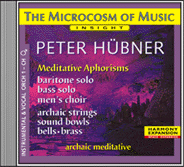 | |
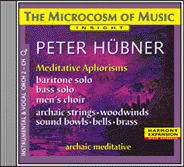 | |
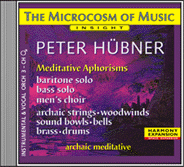 | |
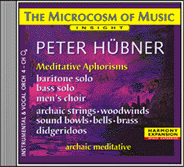 | |
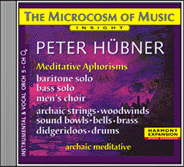 | |
| Peter Hübner Meditative Aphorisms Instrumental – Orchestra No. 1-5 Label: Harmony Expansion playing time: 5h 28’07” | |
© A A R E D I T I O N I N T E R N A T I O N A L 2001